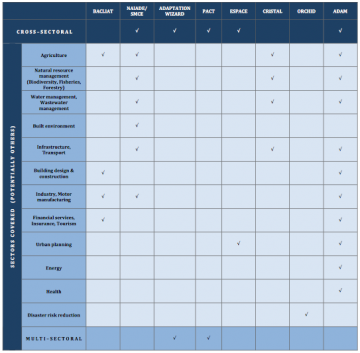Exploring tools from a SECTOR-oriented lens

This section analysis tools looking at them in a horizontal manner, using two criteria:
- 1. Cross-sectoral tools, look at more than one sector simultaneously; Example: ADAM: Mainstreaming Adaptation Into Regional Land Use Planning In the Guadiana River Basin;
- 2. Sector specific vs multi-sectoral tools, cover either one sector specifically, or are not sector specific; Example (sector specific): UKCIP BACLIAT checklist & CRiSTAL: Drought, Vulnerable Communities And Adaptation In Makoya, Chingali, And Manchali; Example (multi-sectoral): UKCIP Adaptation Wizard.
The table below classifies these tools accordingly:

Download table
BACLIAT covers the following sectors: agriculture, building and construction, motor manufacturing, and financial services. The tool has been used in the UK, and applied to agriculture, building design and construction, motor manufacturing, and financial services sectors. There is less emphasis on cross-sector interactions. These would need to be derived by the user.
NAIADE/SCME is cross-sectoral, and covers the following sectors: built environment, transport (local, regional, and national), agriculture and forestry, and waste, water and wastewater industry. The method has been applied in a participatory way on several occasions, by means of combining the use of MCA software with input from focus groups and interviews.
Examples include:
- 1. Water management in the municipality of Troina, Sicily (De Marchi, et al., 2000, Funtowicz et al., 1998);
- 2. Exploration of alternatives to development of an area around a National Park in the Pyrenees under threat of sky resort expansion (Munda, 2004; Tabara, 2003);
- 3. Plausible electrification alternatives in a rural area covering the Biosphere Reserve of El Montseny nearby Barcelona (Russi, D. 2004).
ADAPTATION WIZARD looks at cross-sectoral impacts and is not sector-specific. The tool has been used in the UK, with an application time inferior to one month.
PACT is cross-sectoral, and multi-sectoral. The tool has been applied in the UK, with the example of the Hampshire County Council. (Note: this tool has been superseeded by CaDD).
ESPACE assesses impacts at a cross-sectoral scale, and focuses on urban planning.
CRISTAL covers the following sectors: agriculture, water resource management, infrastructure, and natural resource management, at the community scale (local and regional scales). The tool has been applied in Nicaragua, Mali, Tanzania, and Sri Lanka, with an application time inferior to one month.
ORCHID is an integrated approach to disaster risk reduction and adaptation to future climate change, at regional and national scales. The ORCHID methodology has been piloted in DFID country offices in Bangladesh and India, tested in China, and was adapted for use (as CRISP) for broader sector support in Kenya. The application time varied from two to six months.
ADAM is cross-sectoral and covers agriculture, biodiversity (and nature conservation), buildings and construction, energy, fisheries, forestry, health, industry, insurance and financial services, tourism, transport, urban planning and design, and water resources, by landscape type (urban, rural, coastal), and is geographically non-specific.
Learning examples are supplied in the following areas:
Comparative analysis: London, Greater Manchester and Berlin
Urban water supply (Cape Town)
Developing an adaptation platforms (weADAPT last updated in 2009)
View our
Case studies: Sector-oriented lens
Review of Adaptation Decision Tools
Introduction: Reviewing of adaptation decision tools
Reviewing tools that use a bottom-up approach & recommendations
PACT (Note: this tool has been superseeded by CaDD)
Conditions of Applicability
Case Studies
(0) Comments
There is no content